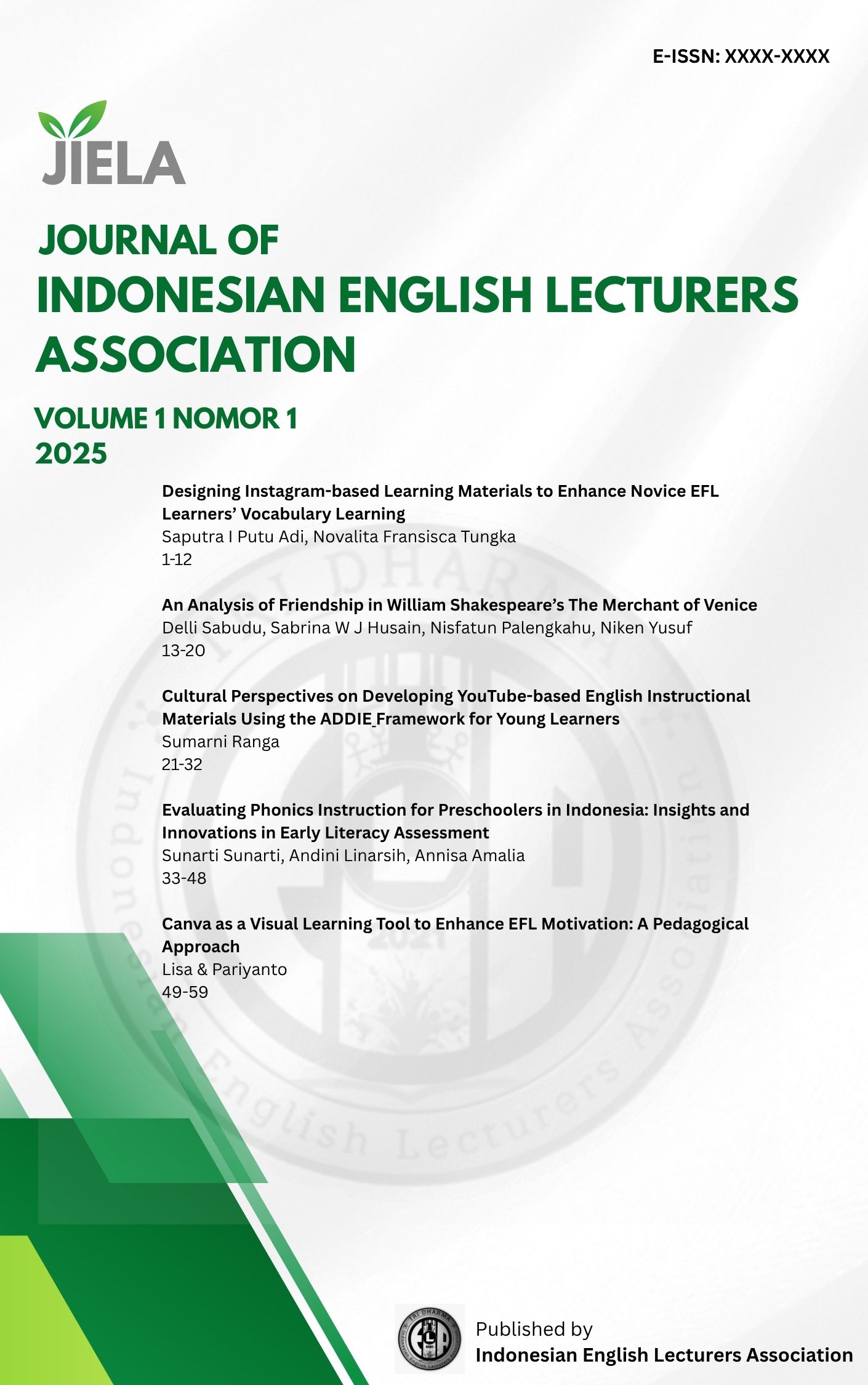Evaluating Phonics Instruction for Preschoolers in Indonesia: Insights and Innovations in Early Literacy Assessment
Keywords:
phonics, assessment, blendingAbstract
Learning assessment is crucial for evaluating the effectiveness of instructional approaches. This study examines the assessment of early English reading skills through the phonics method in a bilingual kindergarten in Indonesia, focusing on children aged 5–6 years. Using a descriptive qualitative method, data were collected through observation, interviews, and documentation. The sole participant in this research is an English teacher instructing the Kindergarten 2 Neverland class. The assessment covers letter-sound recognition, segmentation skills, and blending abilities, which are essential for early literacy development. However, this study is limited by the inclusion of only one informant, providing data from a single perspective. Additionally, the research focuses solely on specific aspects of phonics-based reading assessment, which may not capture the broader dimensions of early literacy acquisition. Despite these limitations, the findings emphasize the importance of assessing early English reading skills through the phonics method, highlighting its role in fostering foundational literacy in young learners. The insights gained from this study contribute to a better understanding of phonics-based assessment in bilingual education settings and underscore the need for continued research on effective literacy instruction for early childhood learners.
References
Abadi, R. F., Mulya, D., & Rosaliana, D. A. (2021). Penerapan media balok magnet dalam meningkatkan keterampilan membaca permulaan terhadap anak dengan hambatan intelektual. Jurnal Unik: Pendidikan Luar Biasa, 6(1), 6-12. http://dx.doi.org/10.30870/unik.v6i1.11864
Adams, M. J. (1990). Beginning to read : thinking and learning about print. MIT Press.
Bald, J. (2007). Using phonics to teach reading and spelling. Thousand Oaks.
Bardovi-Harlig, K. (2014). Documenting interlanguage development. In Interlanguage (pp. 127-146). John Benjamins Publishing Company.
Boud, D., & Dawson, P. (2023). What feedback literate teachers do: an empirically-derived competency framework. Assessment & Evaluation in Higher Education, 48(2), 158-171.
Bowers, J. S., & Bowers, P. N. (2018). Progress in reading instruction requires a better understanding of the English spelling system. Current Directions in Psychological Science, 27(6), 407-412. https://doi.org/10.1177/0963721418773749
Demirdöğen, B., & Korkut, H. M. (2021). Does teacher education matter? Comparison of education and science major teachers’ assessment literacy. Eğitimde Nitel Araştırmalar Dergisi, (26), 23-52.
Ehri, L. C. (2022). What teachers need to know and do to teach letter–sounds, phonemic awareness, word reading, and phonics. The Reading Teacher, 76(1), 53-61. 8 https://doi.org/10.1002/trtr.2095
Fitrianti, L. (2018). Prinsip kontinuitas dalam evaluasi proses pembelajaran. Al-Ishlah: Jurnal Pendidikan, 10(1), 89-102. https://doi.org/10.35445/alishlah.v10i1.68
Gove, A. K., & Wetterberg, A. (Eds.). (2011). The early grade reading assessment: Applications and interventions to improve basic literacy. rti Press.
Jihad, A. (2013). Evaluasi Pembelajaran. Multi Presindo.
Johnston, R., & Watson, J. (2007). Teaching synthetic phonics. Learning Matters.
Junanto, S., & Kusna, N. A. A. (2018). Evaluasi program pembelajaran di PAUD inklusi dengan model Context, Input, Process, and Product (CIPP). Inklusi, 5(2), 179-194. https://doi.org/10.14421/ijds.050202
Latif, M., Zukhairina, Zubaidah, R., & Afandi, M. (2013). Orientasi baru pendidikan anak usia dini. Kencana.
Lyon, A. (2003). Sound systems: Explicit, systematic phonics in early literacy contexts. Stenhouse Publishers.
Magdalena, I., Fauzi, H. N., & Putri, R. (2020). Pentingnya evaluasi dalam pembelajaran dan akibat memanipulasinya. Jurnal Pendidikan dan Sains, 2(2), 244–257.
Mardani, P. S. (2022). Penggunaan media animasi bergambar dalam mengembangkan keterampilan membaca permulaan anak usia dini. PAUD Lectura: Jurnal Pendidikan Anak Usia Dini, 5(02), 63-75. https://doi.org/10.31849/paud-lectura.v5i02.8778
Othman, Y., Daud, A. M., Othman, A., Mohiddin, D. S. A. P., & Sulaiman, M. M. (2016). Pelaksanaan pengajaran membaca menggunakan kaedah fonik peringkat prasekolah di Brunei Darussalam. Jurnal Pendidikan Bahasa Melayu, 2(1), 93-109.
Phajane, M. H. (2014). Introducing beginning reading using phonics approach. Mediterranean Journal of Social Sciences, 5(10), 477-483. https://doi.org/10.5901/mjss.2014.v5n10p477
Rahayu, Y. S., Widiastuti, R., & Kusnandar, A. (2024). Using RCRR (read, cover, remember, and retell) in enhancing the first grade students' reading comprehension ability. SIMPLE: International Journal of English Education, 2(1), 1-7. https://doi.org/10.24176/simple.v2i1.12171
Rahwati, S., & Windarsih, C. A. (2021). Implementasi Metode Phonics Dalam Pengenalan Bahasa Inggris Dan Membaca Permulaan Anak Usia Dini. CERIA (Cerdas Energik Responsif Inovatif Adaptif), 4(1), 29-37.
Sanjaya, I. G. H., Dewi, N. L. P. E. S., & Paramartha, A. A. G. Y. (2022). An investigation of teaching aids used by English teachers in teaching vocabulary for young learners. Journal of Educational Study, 2(1), 26-34. https://doi.org/10.36663/joes.v1i2.227
Santrock, J. W. (2010). Child Development. Mcgraw-Hill.
Seefeldt, C., & Wasik, B. A. (2008). Pendidikan Anak Usia Dini (Menyiapkan Anak Usia, Tiga, Empat dan Lima Tahun Masuk Sekolah). PT Indeks.
Sudiarta, I. G. P., & Widana, I. W. (2019, October). Increasing mathematical proficiency and students character: lesson from the implementation of blended learning in junior high school in Bali. In Journal of Physics: Conference Series (Vol. 1317, No. 1, p. 012118). IOP Publishing.
Sutarsyah, C. (2015). Reading Theory and Practice. Graha Ilmu.
Tønnessen, F. E., & Uppstad, P. H. (2015). Can we read letters? Reflections on fundamental issues in reading and dyslexia research (p. 148). Brill.
Virdyna, N. K. (2015). Penerapan metode fonik dalam pembelajaran bahasa Inggris bagi anak usia dini. OKARA: Jurnal Bahasa dan Sastra, 9(1), 113-130.
Westhisi, S. M. (2019). Metode fonik dalam pembelajaran membaca permulaan bahasa inggris anak usia dini. Tunas Siliwangi: Jurnal Program Studi Pendidikan Guru PAUD STKIP Siliwangi Bandung, 5(1), 23-37. https://doi.org/10.22460/ts.v5i1p29-43.1271
Yan, Z., & Boud, D. (2021). Conceptualising assessment-as-learning. In Assessment as learning (pp. 11-24). Routledge.
Yansyah, Y. (2015). Helping Young Learners to Learn Audio Discrimination by Using Flashcards. LET: Linguistics, Literature and English Teaching Journal, 5(1), 75-81.
Yus, A. (2015). Penilaian Perkembangan Belajar Anak Taman Kanak-kanak. Kencana.
Zhang, C., Yan, X., & Wang, J. (2021). EFL teachers’ online assessment practices during the COVID-19 pandemic: Changes and mediating factors. The Asia-Pacific Education Researcher, 30, 499-507.
Downloads
Published
Issue
Section
License
Copyright (c) 2022 International Journal of IELA (IJOIELA)

This work is licensed under a Creative Commons Attribution 4.0 International License.







